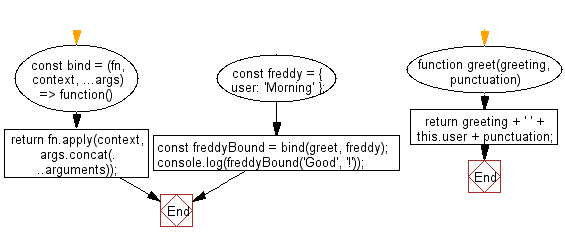JavaScript: Create a function that invokes fn with a given context
JavaScript fundamental (ES6 Syntax): Exercise-59 with Solution
Invoke Function in Given Context
Write a JavaScript program to create a function that invokes fn in a given context. Optionally add any additional variables to the arguments beginning.
- Return a function that uses Function.prototype.apply() to apply the given context to fn.
- Use the spread operator (...) to prepend any additional supplied parameters to the arguments.
Sample Solution:
JavaScript Code:
//#Source https://bit.ly/2neWfJ2
// Define a function 'bind' to bind a context and arguments to a function.
const bind = (fn, context, ...args) =>
// Return a new function that applies the original function with the provided context and arguments.
function() {
return fn.apply(context, args.concat(...arguments));
};
// Define a function 'greet' to concatenate a greeting with a user and punctuation.
function greet(greeting, punctuation) {
return greeting + ' ' + this.user + punctuation;
}
// Define an object 'freddy' with a 'user' property.
const freddy = { user: 'Morning' };
// Bind the 'greet' function to the 'freddy' object.
const freddyBound = bind(greet, freddy);
// Call the bound function with additional arguments.
console.log(freddyBound('Good', '!')); // Output: "Good Morning!"
Output:
Good Morning!
Flowchart:

Live Demo:
See the Pen javascript-basic-exercise-59-1 by w3resource (@w3resource) on CodePen.
For more Practice: Solve these Related Problems:
- Write a JavaScript program that creates a function which invokes another function with a specified this context.
- Write a JavaScript function that uses Function.prototype.call to execute a function in a given context.
- Write a JavaScript program that binds a function to an object and then immediately invokes it with additional arguments.
Go to:
PREV : Split Values into Groups by Predicate.
NEXT : Invoke Object Method by Key.
Improve this sample solution and post your code through Disqus
What is the difficulty level of this exercise?
Test your Programming skills with w3resource's quiz.
